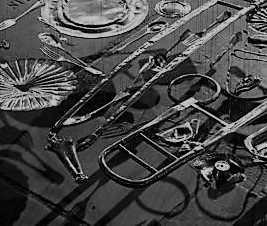I have been writing about objects of commemoration … Achievement objects such as Trophies and medals designed for the purpose of marking accomplishment and triumph which are often treasured. On occasion these may be worn on our bodies with pride to inform others of our special quality or stored in the cabinet of forbidden to touch objects. The wearing of objects can come in the form of badges and clothing to mark a moment in time and outwardly tell others of our experience. Perhaps the most significant example of this is the wearing of precious metals and stones to mark personal achievement, love, and status, from silver trophies to wedding rings, perhaps these are our most treasured objects, those which we may remain with even after death.
Silver is commemorative, the objects are landmarks in people’s lives. I wanted to change their meaning, their visibility, their worth, that is why I flattened them, consigning them all to the same fate. (‘Thirty Pieces of Silver’, Cornelia Parker, 1988–9 | Tate, 2021)
I thought of Cornelia Parker and her piece Thirty Pieces of Silver. I watched a video which accompanied the installation at York St Mary’s. Although this piece references objects of commemoration she is more concerned with the new life of a material in an object of art, (she is less concerned with their past significance). She describes this as the work itself being a residue of process. I connect with this way of thinking about process. My current painting is documentation an evolving timeline/process of documenting and vital to the work. The covering and uncovering of layers of paint document my changes of mind and new ideas, the end result is a residue of this. It would not be the same if I attempted to pull everything together in a painting made a week before I expected to be complete.
Parker also talks about Material, what I understand to be the ingredients of the work (the silver objects) and then the anti-matter which is the transformation of the objects into something new (the work). This is interesting to me as it also aligns with my thinking in terms of the objects which I am documenting and their continually changing context over time, ownership and place as well as the transformative process.
Thirty Pieces of Silver’ is about materiality and then about anti-matter. In the gallery the ruined objects are ghostly levitating just above the floor, waiting to be reassessed in the light of their transformation. (‘Thirty Pieces of Silver’, Cornelia Parker, 1988–9 | Tate, 2021)
(Quoted in British Art Show, exhibition catalogue, Hayward Gallery, London 1990, p.88.)
Parker is not interested simply in the destruction of materials, but more their resurrection and transformation.
Parker has since made many other works involving silver. For example, to make Measuring Niagara with a Teaspoon 1997 (Tate T07430), she took a Georgian teaspoon and had it melted down and then drawn into a wire whose length was equal to the height of the Niagara Falls. The value and meaning of silver, as well as its physical properties, have been a source of continual fascination for her. She has said that this is ‘because it is the most reflective metal that exists and [it] also has the ability to be the opposite very dull and black, it has the plus and minus in one material. Also linguistically in terms of the use of silver in language, ‘silver tongued’, silver lining’. It has a very poetic aura around it, it’s used in mirrors in which we see ourselves and in telescopes to look at the universe … It’s part of our cultural make-up somehow, it has all kinds of ways of being in the world. Metals, in general, I love but I think that silver is my favourite’. (Quoted in unpublished excerpt of interview with Tate curator Virginia Button, 1998.)
Tate. 2021. ‘Thirty Pieces of Silver’, Cornelia Parker, 1988–9 | Tate. [online] Available at: <https://www.tate.org.uk/art/artworks/parker-thirty-pieces-of-silver-t07461> [Accessed 30 December 2021].

Recent Comments